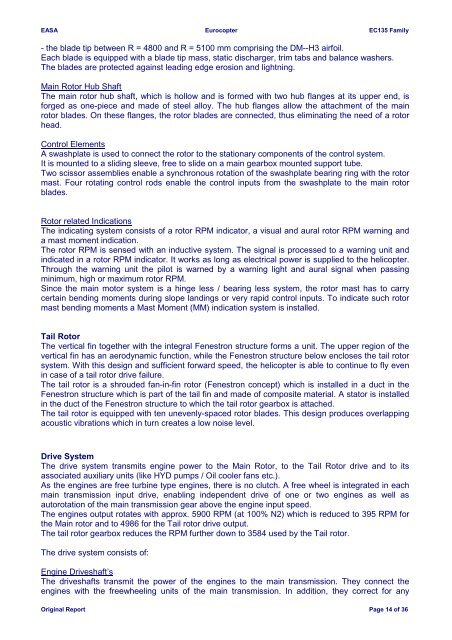Final report EC 135 Family-23 07 12 - EASA
Final report EC 135 Family-23 07 12 - EASA
Final report EC 135 Family-23 07 12 - EASA
You also want an ePaper? Increase the reach of your titles
YUMPU automatically turns print PDFs into web optimized ePapers that Google loves.
<strong>EASA</strong> Eurocopter <strong>EC</strong><strong>135</strong> <strong>Family</strong><br />
- the blade tip between R = 4800 and R = 5100 mm comprising the DM--H3 airfoil.<br />
Each blade is equipped with a blade tip mass, static discharger, trim tabs and balance washers.<br />
The blades are protected against leading edge erosion and lightning.<br />
Main Rotor Hub Shaft<br />
The main rotor hub shaft, which is hollow and is formed with two hub flanges at its upper end, is<br />
forged as one-piece and made of steel alloy. The hub flanges allow the attachment of the main<br />
rotor blades. On these flanges, the rotor blades are connected, thus eliminating the need of a rotor<br />
head.<br />
Control Elements<br />
A swashplate is used to connect the rotor to the stationary components of the control system.<br />
It is mounted to a sliding sleeve, free to slide on a main gearbox mounted support tube.<br />
Two scissor assemblies enable a synchronous rotation of the swashplate bearing ring with the rotor<br />
mast. Four rotating control rods enable the control inputs from the swashplate to the main rotor<br />
blades.<br />
Rotor related Indications<br />
The indicating system consists of a rotor RPM indicator, a visual and aural rotor RPM warning and<br />
a mast moment indication.<br />
The rotor RPM is sensed with an inductive system. The signal is processed to a warning unit and<br />
indicated in a rotor RPM indicator. It works as long as electrical power is supplied to the helicopter.<br />
Through the warning unit the pilot is warned by a warning light and aural signal when passing<br />
minimum, high or maximum rotor RPM.<br />
Since the main motor system is a hinge less / bearing less system, the rotor mast has to carry<br />
certain bending moments during slope landings or very rapid control inputs. To indicate such rotor<br />
mast bending moments a Mast Moment (MM) indication system is installed.<br />
Tail Rotor<br />
The vertical fin together with the integral Fenestron structure forms a unit. The upper region of the<br />
vertical fin has an aerodynamic function, while the Fenestron structure below encloses the tail rotor<br />
system. With this design and sufficient forward speed, the helicopter is able to continue to fly even<br />
in case of a tail rotor drive failure.<br />
The tail rotor is a shrouded fan-in-fin rotor (Fenestron concept) which is installed in a duct in the<br />
Fenestron structure which is part of the tail fin and made of composite material. A stator is installed<br />
in the duct of the Fenestron structure to which the tail rotor gearbox is attached.<br />
The tail rotor is equipped with ten unevenly-spaced rotor blades. This design produces overlapping<br />
acoustic vibrations which in turn creates a low noise level.<br />
Drive System<br />
The drive system transmits engine power to the Main Rotor, to the Tail Rotor drive and to its<br />
associated auxiliary units (like HYD pumps / Oil cooler fans etc.).<br />
As the engines are free turbine type engines, there is no clutch. A free wheel is integrated in each<br />
main transmission input drive, enabling independent drive of one or two engines as well as<br />
autorotation of the main transmission gear above the engine input speed.<br />
The engines output rotates with approx. 5900 RPM (at 100% N2) which is reduced to 395 RPM for<br />
the Main rotor and to 4986 for the Tail rotor drive output.<br />
The tail rotor gearbox reduces the RPM further down to 3584 used by the Tail rotor.<br />
The drive system consists of:<br />
Engine Driveshaft’s<br />
The driveshafts transmit the power of the engines to the main transmission. They connect the<br />
engines with the freewheeling units of the main transmission. In addition, they correct for any<br />
Original Report Page 14 of 36

















